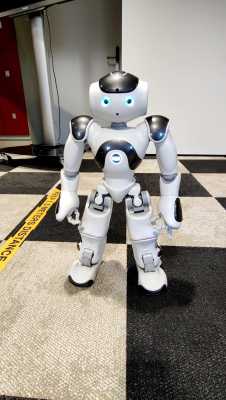Humanoid Robot
Advantages of humanoid robots
Humanoid robots have various advantages when used for interacting with patients suffering from major neurocognitive disorders. First of all, patients are likely to become more engaged and act more positively in the interaction with a human-like robot compared to robots without physical embodiment [1,2,3]. Besides, the quality of life of patients has also been proved to improve with the application of humanoid robots helping with daily issues. Furthermore, physical robots can implement non-verbal cues such as movement detection, hand gesture recognition, etc. which can also help give hints on the actions that patients need to take [4].
To gain those advantages, a humanoid robot needs to be easy to operate and must be accepted as part of the home environment [1]. Being small enough to fit into a home environment, easy to use, and child-like shaped, NAO satisfies all these requirements. However, research has also shown that cognitive decline is not prevented by frequent interactions with NAO for patients suffering from advanced dementia [3], on which our team will work to seek improvement.
The NAO Robot

NAO is a human-like child-sized robot that can speak, listen, see and move around by the help of its numerous sensors and motors. The robot is battery powered, internet connected and is able to loudly play music trough it's speakers.
Use of NAO
The robot will be used to remind patients with dementia of their schedule with music, improving their cognition. This is done by playing personalized music at the correct time of day. Some of the music that corresponds with activities not sensitive to time can be adjusted to be played only when movement is detected. When the patient does not remember the meaning of a particular piece of music, they are able to interact with the robot by asking. Moreover, patients can denote finishing an activity by making an ok-sign at the robot. If the patient has not confirmed finishing the activity after a certain time interval, the robot can replay the music to remind again. When confirmation is not done after several tries, a caregiver or loved one will be automatically contacted to check the patient's condition.
The robot can help improve the memory of patients by playing quizzes. The quiz will be instigated by the robot maximum once randomly during the day or be instigated by the user when wanted, which the patient can also choose not to play. The quiz mainly consists of part of the personalized music and the patient needs to say the corresponding activities correctly to pass the quiz. The robot may help the patient remember the activity by giving verbal or non-verbal hints.
Reference
[1] McTear, M. F., Callejas, Z., & Griol, D. (2016). The conversational interface (Vol. 6, No. 94, p. 296). Cham: Springer.
[2] Powers, A., Kiesler, S., Fussell, S., & Torrey, C. (2007). Comparing a Computer Agent with a Humanoid Robot. Proceedings of the ACM/IEEE International Conference on Human-Robot Interaction, 145–152. Presented at the Arlington, Virginia, USA. doi:10.1145/1228716.1228736
[3] Valentí Soler, M., Agüera-Ortiz, L., Olazarán Rodríguez, J., Mendoza Rebolledo, C., Pérez Muñoz, A., Rodríguez Pérez, I., … Martínez Martín, P. (2015). Social robots in advanced dementia. Frontiers in Aging Neuroscience, 7. doi:10.3389/fnagi.2015.00133
[4] Han, J., Campbell, N., Jokinen, K., & Wilcock, G. (12 2012). Investigating the use of Non-verbal Cues in Human-Robot Interaction with a Nao robot. 679–683. doi:10.1109/CogInfoCom.2012.6421937